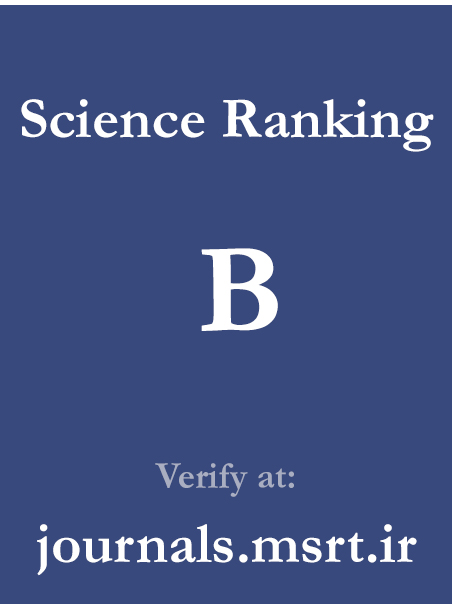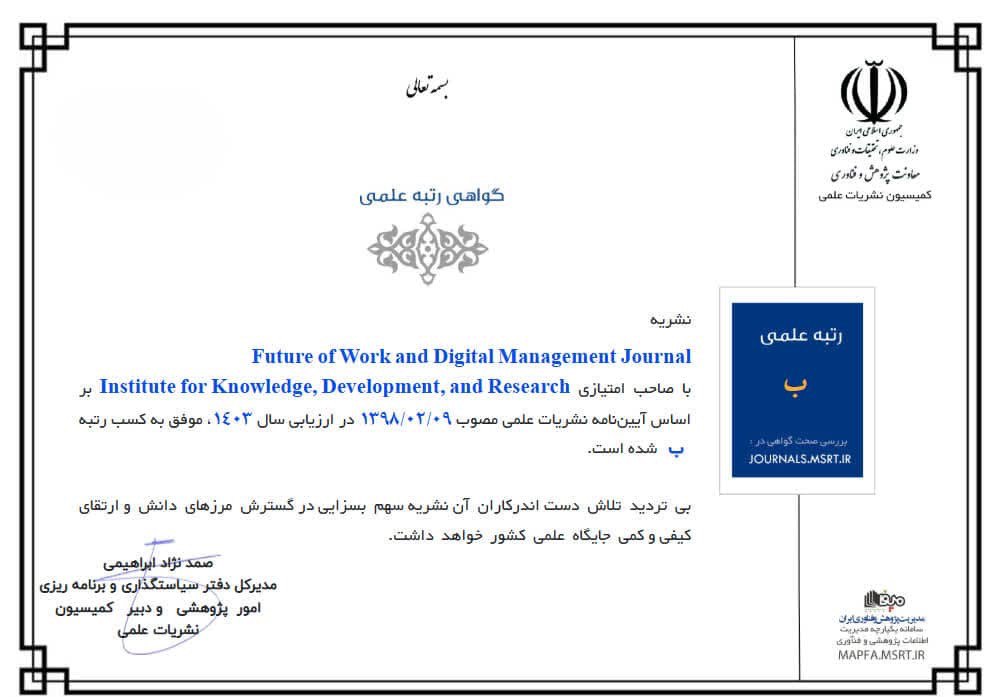A Qualitative Study of Communication Overload in Remote Collaboration
Keywords:
communication overload, remote collaboration, digital fatigue, qualitative research, virtual teamsAbstract
This study aimed to explore the lived experiences, causes, and consequences of communication overload among professionals engaged in remote collaboration. This qualitative research employed a phenomenological design to investigate how individuals experience communication overload in remote work environments. Twenty-one participants from Tehran with a minimum of six months of remote collaboration experience were selected through purposive sampling. Data were collected using semi-structured interviews and analyzed using thematic content analysis with NVivo software. Theoretical saturation was achieved by the twenty-first interview, and a systematic coding process was applied to extract meaningful units, subcategories, and overarching themes. Analysis revealed four main categories: cognitive and emotional consequences, communication structure and flow, coping and adaptation strategies, and organizational and technological factors. Participants reported experiencing mental fatigue, emotional exhaustion, and reduced job satisfaction as outcomes of communication overload. Structural issues such as fragmented message flows, unclear norms, and excessive synchronous communication were frequently cited. Coping mechanisms included selective engagement, boundary-setting, and customization of tools. Organizational factors such as lack of communication policy, poor platform integration, and digital surveillance further intensified overload. The findings align with prior research emphasizing the psychological toll of unregulated digital communication and the need for human-centered virtual collaboration strategies. Communication overload in remote collaboration is a multifaceted phenomenon shaped by individual, structural, and organizational dynamics. Addressing it requires clear communication policies, streamlined tool integration, and a shift toward empathetic digital work design. These findings contribute to the broader understanding of remote work sustainability and offer practical insights for organizational leaders and digital platform developers.
Downloads
References
[1] Q. Fan, Y. Li, Z. Xu, and Y. Wang, "The Impact of Remote Work on Communication Efficiency and Productivity in Multinational Corporations," Fe, vol. 1, no. 10, 2024, doi: 10.61173/wwn1w956.
[2] S. Zhao, "Collaborative Virtual Learning Environments: A Structure for Designing Digital Educational Materials," International Journal of Interactive Mobile Technologies (Ijim), vol. 18, no. 23, pp. 4-14, 2024, doi: 10.3991/ijim.v18i23.51373.
[3] K. Swart, T. J. Bond-Barnard, and R. Chugh, "Challenges and Critical Success Factors of Digital Communication, Collaboration and Knowledge Sharing in Project Management Virtual Teams: A Review," International Journal of Information Systems and Project Management, vol. 10, no. 4, pp. 59-75, 2022, doi: 10.12821/ijispm100404.
[4] K. Zheng, B. Stein, and R. Farzan, "Use Ping Wisely: A Study of Team Communication and Performance Under Lean Affordance," Acm Transactions on Social Computing, vol. 5, no. 1-4, pp. 1-26, 2022, doi: 10.1145/3557022.
[5] K. Syynimaa, K. Lainema, and T. Lainema, "Identifying Challenges in Virtual Teams: A Case Study of Teamwork in a Game-Based Learning Environment," 2022, doi: 10.33965/celda2022_202207l013.
[6] J. Kuntz and V. Manokore, "“I Did Not Sign Up for This”: Student Experiences of the Rapid Shift From in-Person to Emergency Virtual Remote Learning During the COVID Pandemic," Higher Learning Research Communications, vol. 12, no. 0, 2022, doi: 10.18870/hlrc.v12i0.1316.
[7] Y. Cleary, D. M. Slattery, M. Flammia, and P. Minacori, "Developing Strategies for Success in a Cross-Disciplinary Global Virtual Team Project: Collaboration Among Student Writers and Translators," Journal of Technical Writing and Communication, vol. 49, no. 3, pp. 309-337, 2018, doi: 10.1177/0047281618775908.
[8] B. González-Anta, V. Orengo, A. Zornoza, N. Gamero, and V. Peñarroja, "Collaboration and Performance in Virtual Teams With Faultlines: An Emotional Management Intervention," Revista Psicologia Organizações E Trabalho, vol. 20, pp. 1237-1246, 2020, doi: 10.17652/rpot/2020.4.08.
[9] D. D. Díaz-Guerra, A. J. P. Gamboa, and C. A. G. Cano, "Social Network Analysis in Virtual Educational Environments: Implications for Collaborative Learning and Academic Community Development," Awari, vol. 4, pp. 1-12, 2023, doi: 10.47909/awari.595.
[10] J. E. Rudzin, D. C. Soule, J. M. Whitaker, H. M. Berger, S. Clayton, and K. E. Fogaren, "Catalyzing Remote Collaboration During the COVID-19 Pandemic and Beyond: Early Career Oceanographers Adopt Hybrid Open Science Framework," Frontiers in Marine Science, vol. 9, 2022, doi: 10.3389/fmars.2022.855192.
[11] R. Whalley and M. K. Barbour, "Collaboration and Virtual Learning in New Zealand Rural Primary Schools: A Review of the Literature," Turkish Online Journal of Distance Education, pp. 102-125, 2020, doi: 10.17718/tojde.727983.
[12] J. Jiang, "Virtual Campus Libraries’ Role in Community Colleges: Benefit, Challenge and Future," International Journal of Librarianship, vol. 9, no. 3, pp. 90-98, 2024, doi: 10.23974/ijol.2024.vol9.3.392.
[13] P. Chanwaiwit and L. Mori, "Fostering Intercultural and Elf Awareness in Business English Students Through Virtual Exchange," Teflin Journal - A Publication on the Teaching and Learning of English, vol. 35, no. 2, pp. 232-247, 2024, doi: 10.15639/teflinjournal.v35i2/232-247.
[14] S. Ala-Kortesmaa and C. Muñoz, "Challenges in Virtual Team Communication in the Context of Virtual Exchange Experience," European Journal of Open Distance and E-Learning, vol. 25, no. 1, pp. 49-61, 2023, doi: 10.2478/eurodl-2023-0004.
[15] J. Meluso, S. M. Johnson, and J. P. Bagrow, "Flexible Environments for Hybrid Collaboration: Redesigning Virtual Work Through the Four Orders of Design," 2020, doi: 10.31235/osf.io/wehsk.
[16] K. Aten, "Virtual Worlds Affordances for Organizations," 2020, doi: 10.1093/acrefore/9780190224851.013.170.
[17] R. Nugrahani, T. Triyanto, W. Wan Juriah Emeih Binti, and W. Wibawanto, "Visual Art Learning in Virtual Community: A Study of Collaborative Learning in Hijabographic Community," 2018, doi: 10.2991/reka-18.2018.87.
[18] N. Vukašinović, J. Benedičič, and R. Žavbi, "Evolution of Communication Skills in Virtual Product Development Process: Experience From EGPR," 2020, doi: 10.5772/intechopen.90059.
[19] A. M. Rashid, L. Sidyawati, N. I. Tukiman, N. M. Suaib, and M. F. M. Ariff, "Digital Preservation of Rumah Tukang Kahar for Cultural Heritage Tourism," Arsnet, vol. 3, no. 2, 2023, doi: 10.7454/arsnet.v3i2.71.
[20] T. J. Jackson, "‘I’ve Never Told Anybody That Before’: The Virtual Archive and Collaborative Spaces of Knowledge Production," pp. 93-106, 2020, doi: 10.1332/policypress/9781447341895.003.0007.
[21] H. Zhao, A. Swanson, A. Weitlauf, Z. Warren, and N. Sarkar, "Hand-in-Hand: A Communication-Enhancement Collaborative Virtual Reality System for Promoting Social Interaction in Children With Autism Spectrum Disorders," Ieee Transactions on Human-Machine Systems, vol. 48, no. 2, pp. 136-148, 2018, doi: 10.1109/thms.2018.2791562.








